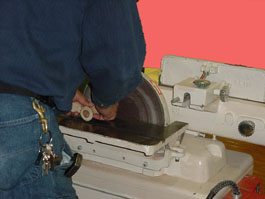Belt/Disk Sander
 The belt and disk sander is widely used in woodworking. The disc sander is used for rough shaping and making outside curves. While the belt sander is used for the purpose of sanding. This sheet will describe the procedures for sanding wood. For other operations ask your instructor or refer to one of the many texts available. |
Controls: The controls on the Belt/Disc Sander in the materials processing laboratory consist of the following:
- The power supply box
- The electrical cord
- The on/off switch
- The disc sander end guard
- The belt sander side guard
Note: There are other controls on various accessories
used with the sander that are not listed in this
discussion.
Procedures in operating the Sander (Sanding): Sanding is the operation to smoothen a piece of wood. Refer to the following procedures.
- Always unplug the cord when the belt/disc sander is not in use.
- Position the electrical cord where it will not come in contact with you and the sander.
- Be sure that the switch is off before you plug in the sander.
- Make sure that the operating controls work.
- Check the belt/disc sander to make sure that the abrasive paper is securely attached to the machine.
- Check the abrasive paper to make sure that it is not worn out.
- Keep the belt/disc sanders clean at all times.
- Place the piece of wood on the sander.
- Do not apply a lot of pressure on the wood.
- Securely hold your work piece.
- Finally, let the sander do the work
Note: There are several other operations that can be done using a belt/disc sander. Ask your instructor and refer to one of the many references for those procedures.
|
|
|
Always sand your stock on the left side of the rotational disc to prevent kickbacks. Note the position of the stock, which is on the left hand side of the rotational disc sander. |
This is the other side of the belt/disc sander. This flat belt helps you utilize both fence guards to allow your stock to be flat against the abrasive paper. |
Potential hazards: Because of the rapid spinning of the belts, the following hazards exist.
- Body contact with the moving abrasive belts
- Long hair, Clothing, Jewelry, could become entangled with the belt
- Flying dust, can be thrown up at the operator
- The operator could slip and fall against the sander
- Flying wood pieces
Safety practices: Because of the potential hazards the following safety rules must be followed.
- Always wear safety glasses when working with the belt/disc sander.
- Remove all the sawdust around the belt/disc sander, which could be a fire hazard.
- Always unplug the cord when you are changing the belt.
- Keep the cord away from the area that you will be sanding.
- Always make sure that the switch is off before plugging the cord into the wall.
- Sand only on dry wood.
- Always keep the stock against the table
- Do not operate if the abrasive paper is loose or torn
- On the disc sander, sand on the down stroke side
References:
Spence, William P., Griffiths, Duane L., (1981). Woodworking Tools, Materials. American Technical Publishers, Inc., Alsip, IL.
Feirer, John L. (1988). Cabinetmaking and Millwork. Glencoe/McGraw-Hill. Peoria, IL.
ITT 252 - Materials Processing
Prepared by Joey Soucy, 9/25/2001

